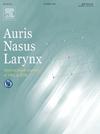A nationwide survey of dysphagia as a complication of deep neck infection with abscess in Japan
IF 1.5
4区 医学
Q2 OTORHINOLARYNGOLOGY
引用次数: 0
Abstract
Objective
Deep neck infection with abscess (DNI) may cause dysphagia as a late complication. This study aimed to determine the rate of DNI related dysphagia (DNIRD) and the effectiveness of rehabilitation and surgery for DNIRD.
Methods
As a multicenter retrospective study, we conducted a nationwide survey by sending questionnaires to specialist training institutions certified by the Japan Broncho-esophagological Society (JBES). The questionnaire was sent to 227 facilities. This survey targeted patients with DNI aged 20 years or older who were hospitalized after April 1, 2011 and discharged by March 31, 2021.
Results
Of the 1058 cases of DNI included in this study, DNIRD was observed in 161 of 1058 patients (15.2 %). Of the 1058 cases of DNI, 139 cases showed descending necrotizing mediastinitis (DNM) (13.1 %), and DNIRD was observed in 64 of the DNM cases (46 %). DNIRD cases tended to be older (71 ± 13.5 vs. 64 ± 17.7 years old, p < 0.001), have a higher tracheostomy rate (91.3 % vs. 43.7 %, p < 0.0001), and have a longer hospital stay (51 ± 34.7 vs. 17 ± 15.4 days, p < 0.0001) than non-DNIRD cases. There were 125 cases in which only rehabilitation was performed, 8 cases in which surgery was performed to improve swallowing function, and 28 cases in which the natural course was observed. The improvement rates of DNIRD in the natural history group, rehabilitation group, and surgery group were 78.6 %, 91.8 %, and 100 %, respectively, and the rehabilitation group tended to improve more than the natural course group (p = 0.08).
Conclusion
This nationwide survey revealed that 15.2 % of patients with DNI resulted in DNIRD and that 46 % of descending necrotizing mediastinitis patients developed DNIRD. Rehabilitation for DNIRD is generally useful, and that additional surgical treatment can improve outcomes for DNIRD patients where rehabilitation alone is not effective.
吞咽困难是日本深颈部感染并发脓肿并发症的一项全国性调查。
目的:深颈部脓肿感染(DNI)可引起吞咽困难,是一种晚期并发症。本研究旨在确定DNI相关吞咽困难(DNIRD)的发生率以及DNIRD的康复和手术治疗的有效性。方法:作为一项多中心回顾性研究,我们通过向日本支气管食管学会(JBES)认证的专科培训机构发送问卷,在全国范围内进行调查。问卷被发送到227个设施。本次调查的对象是2011年4月1日后住院、2021年3月31日前出院的20岁及以上DNI患者。结果:在本研究纳入的1058例DNI中,1058例患者中有161例(15.2%)出现dird。1058例DNI中,下行坏死性纵隔炎(DNM) 139例(13.1%),DNM中出现dird 64例(46%)。DNIRD患者年龄较大(71±13.5岁比64±17.7岁,p < 0.001),气管造瘘率较高(91.3%比43.7%,p < 0.0001),住院时间较长(51±34.7天比17±15.4天,p < 0.0001)。仅行康复治疗125例,手术改善吞咽功能8例,观察自然过程28例。自然病程组、康复组、手术组DNIRD的改善率分别为78.6%、91.8%、100%,康复组较自然病程组更有改善的趋势(p = 0.08)。结论:这项全国性调查显示,15.2%的DNI患者发生DNIRD, 46%的下行坏死性纵隔炎患者发生DNIRD。对DNIRD进行康复治疗通常是有用的,对于仅靠康复治疗无效的DNIRD患者,额外的手术治疗可以改善其预后。
本文章由计算机程序翻译,如有差异,请以英文原文为准。
求助全文
约1分钟内获得全文
求助全文
来源期刊

Auris Nasus Larynx
医学-耳鼻喉科学
CiteScore
3.40
自引率
5.90%
发文量
169
审稿时长
30 days
期刊介绍:
The international journal Auris Nasus Larynx provides the opportunity for rapid, carefully reviewed publications concerning the fundamental and clinical aspects of otorhinolaryngology and related fields. This includes otology, neurotology, bronchoesophagology, laryngology, rhinology, allergology, head and neck medicine and oncologic surgery, maxillofacial and plastic surgery, audiology, speech science.
Original papers, short communications and original case reports can be submitted. Reviews on recent developments are invited regularly and Letters to the Editor commenting on papers or any aspect of Auris Nasus Larynx are welcomed.
Founded in 1973 and previously published by the Society for Promotion of International Otorhinolaryngology, the journal is now the official English-language journal of the Oto-Rhino-Laryngological Society of Japan, Inc. The aim of its new international Editorial Board is to make Auris Nasus Larynx an international forum for high quality research and clinical sciences.
 求助内容:
求助内容: 应助结果提醒方式:
应助结果提醒方式:


